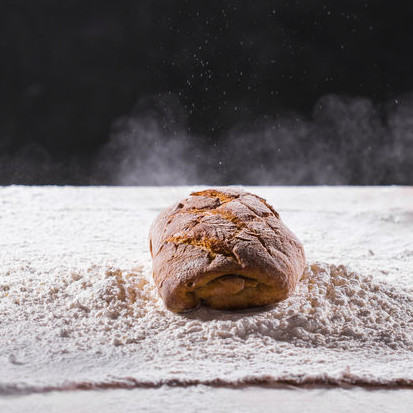
High Gluten Wheat Flour
Also known as high-protein wheat flour
What is High Gluten Wheat Flour?
High gluten wheat flour is made from grinding U.S. hard red winter (HRW) and hard red spring (HRS) wheats to produce a finished product with 13.0–15.0% protein. This flour may also be produced from Canadian wheat, such as Canadian Western Red Spring (CWRS). It is made up of almost pure endosperm and is best suited for the production of baked goods which require high strength and structure.
Distinct properties of high gluten wheat flour include:
- High protein content
- Superior baking quality
- Great for artisan, sourdough and breads made with preferments
Origin
Wheats used in the production of high gluten flours are cultivated in many areas of the world. Currently, high gluten wheat varieties are grown in the majority of the continental U.S. Montana, North Dakota, South Dakota and Minnesota are major producers of hard wheat varieties that are well suited for production of high gluten flour.
Function
Due to its high protein content, high gluten flour is characterized by:
- Ability to form strong gluten structure essential for artisan, sourdough and hearth breads with desirable crustiness and chewiness.
- Participation in Maillard browning reactions and subsequent crust color. High protein flours contain high levels of amino acids that react with sugars to form brown crust during baking and can participate in Maillard browning reactions during baking.
Nutrition and health
Typical composition of high gluten flours:
- Moisture: 12.0–14.0%
- Protein: 13.0–15.0%
- Fat: 0.7–1.0%
- Carbohydrates: 70.0%
- Ash: 0.30–0.40%
High levels of B-vitamins mainly niacin and folic acid are characteristics of high gluten flours.
Commercial production
High gluten flour is usually a short patent flour from hard wheat that has been selectively milled. Its production follows the same principles of standard wheat milling operations. The main difference here is that the blending of milled wheat fractions and streams is more selective to ensure that lower levels of shorts and bran end up in the finished product.1
Post-milling treatments
High gluten flours are often treated with potassium bromate and bleached with benzoyl peroxide. The FDA requires that all flours be enriched with thiamin, riboflavin, niacin, folic acid and iron. High gluten wheat flour may not undergo post-milling treatment in order to comply with today’s clean label markets.
Application
High gluten wheat flour is almost exclusively marketed at retail level and used by premium or artisan bakeshops. Adoption of high gluten flour at wholesale level has been limited due to its high price compared to higher extraction flours. It is best suited for bagels, pizza and hard rolls.
Contribution of high gluten wheat flour to baked goods:
- The high protein quantity and quality lead to higher absorption doughs with extended mixing times.
- Longer fermentation periods are required to obtain equivalent mellowing effect on gluten matrix
- Ash content is lower than standard 74.0–75.0% extraction flours from HRW or CWRS wheat
- Given its relatively low extraction rate, it carries a lower enzymatic load. As long as there is no sprout damage at crop level, the Falling Number of this type of flour is often high (about 450–550 s)
- Dough exhibits a more elastic character and notably higher resistance to deformation. More water is hence needed to center curve at 500 BU and 1.1 Nxm line, during Farinograph and Mixolab test, respectively
- Its limited pan flow makes it suitable for the production of hearth bread
High gluten wheat flour can be used in combination with other bread flours in the production of multigrain and rye bread to reduce the “denseness” of the finished products.
San Francisco sourdough starters are generally prepared with high gluten flour to compensate for the highly acidic environment developed in the dough that negatively degrades the gluten structure after typical fermentation times.
Improvers for high gluten flour
- Malt flour as fermentation aid
- Ascorbic acid for improved gas retention and oven-spring
- Protease to modify handling properties of dough (e.g. extensibility)
References
- Finnie, S., and Atwell, W.A. “Milling.” Wheat Flour, 2nd Edition, AACC International, Inc., 2016, pp. 17–30.

